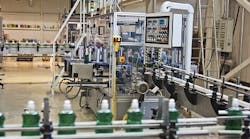With humans becoming a vanishing breed in factories, machine-to-machine communications will grow in importance when food manufacturers seek to leverage the Internet of Things. Photo: Automation Direct
As catch phrases go, the Internet of Things has a certain Buck Rogers ring to it. IoT already has trumped Big Data and network connectivity when it comes to capturing people’s imagination.
What's catapulting IoT above the level of hype are the changes people already see in the enabling technology. Low-cost sensors and field devices embedded with inexpensive microprocessors are proliferating in automated manufacturing, while cloud computing and the related software-as-a-service (SaaS) is delivering the infrastructure of analytics and data management to food and beverage processors that couldn’t rationalize the cost of conventional systems. IoT remains an immature concept, but the potential is exciting.
Citing a Goldman Sachs report, Don Hsieh, director-commercial and industrial marketing at Tyco Integrated Security, Boca Raton, Fla., notes sensor costs are half today what they were a decade ago, while bandwidth has increased 40 fold and processing speeds are 60 times faster.
The first wave of IoT hardware consists of “fixed users,” the one billion PCs currently connected to the Internet. The three billion mobile devices in use are the second wave, and sensors and “other things” are the third. Within five years, Hsieh recently told the Food Defense Strategy Exchange in Chicago, those other devices will number 30 billion, “and that may be on the low end,” with some suggesting 50 billion is a more probable number.
An open question is how companies will leverage that infrastructure to create the kind of machine-to-machine communication without human involvement envisioned by Kevin Ashton, the technology guru who coined IoT 16 years ago. In “Internet of Things: Science Fiction or Business Fact?” Harvard Business Review Analytic Services cites some early successes, none of which involves the manufacture of goods. Enhanced customer service was IoT’s most likely benefit, according to 51 percent of 269 business people surveyed as part of the report, with “improved use of assets in the field” cited by 38 percent.
Automation vendors are as uncertain as everybody else about how IoT will change industrial manufacturing. Where they do find certainty is in the here and now of the second wave, the explosion of mobile devices that can uncouple plant personnel from HMIs and desktop computers and put real-time data in the palms of technicians, managers and other personnel.
Millennials now outnumber baby boomers in the U.S. workforce, notes Saadi Kermani, product manager for SmartGlance, Schneider Electric’s enabling technology to link plant controls to mobile devices. “They don’t need an office or IT support, they just need to know the job expectations and an app,” says Kermani, who joined the Schneider organization by way of its Invensys acquisition. Described as a mobile reporting connector, SmartGlance “seeks the sweet spot where consumer-friendly devices and apps are married to the industrial data world,” he says.
Rockwell Automation offers a similar connection device known as VantagePoint EMI. “Are companies becoming more open to using mobile devices on the plant floor? Yes,” answers Kyle Reissner, IA mobility platform leader in Rockwell’s Maple Heights, Ohio, center. “Controls engineers are more open to connecting with business systems,” he allows, but whether they prefer data delivery via a desktop browser or a mobile device, they need to quickly aggregate data from controls and other sources to make more effective production decisions. Systems like VantagePoint give them the necessary connectivity and mobility.
Tablets are big and bulky hardware in the pantheon of today’s mobile devices, the second wave of the controls evolution that is occurring. Photo: TechniBlend Inc.
“We’ve been pushing HMI screens to other devices for the last 10-15 years,” Reissner continues, “but now we’re tailoring those screens to an iPad or other mobile device.” More than scaling graphs and data to a smaller screen is involved; the system allows users to “create your own display on the fly,” based on the individual’s information needs.
SmartGlance comes preloaded with screens but there is no controls capability. That’s because it’s not intended to be HMI-lite, Kermani says. There’s also a 30-second delay in uploading controls data to the cloud and back to a mobile device.
“If you need it faster, you should use a HMI,” he advises. But if the objective is to review equipment operating status, OEE trends, inventory status or a host of other tags that can be pulled from SQL servers, historians or other databases, SmartGlance can deliver.
SmartGlance is one of two Schneider SaaS initiatives, the other being Wonderware On-line. An alternative to an in-house data historian, Wonderware On-line allows manufacturers to push equipment data to the cloud, where it is stored on a Schneider “best-in-class historian for an annual subscription fee, at a fraction of the upfront cost” of an in-house historian. Food manufacturers with tight budgets and limited IT expertise are among potential subscribers.
Connecting the plant to mobile devices is a baby step on the IoT road, but change is accelerating. “Once things get onto the digital plain and we begin aggregating that data, what do we do with it?” Kermani asks, before answering his own question: “Machine learning is next.”


